Blueland vs. Cleancult: Which Plastic-Free Laundry & Cleaning Swaps Are Worth Your Time in 2025?
After literal years of testing, this review covers which eco-friendly laundry and cleaning brands are actually worth your time and why. I’m comparing Blueland vs. Cleancult (plus a few noteworthy alternatives). One is among the most sustainable brands on the market, and one still hasn’t convinced me. (Want more? I have a separate review of Dropps, as well as a review of Earth Breeze and TruEarth.)
I didn’t write this because I think sustainable cleaning products are particularly fun or fascinating, I wrote it because they’re an easy change. Plastic pollution can feel impossible to solve, but cleaning products are a pretty painless place to start.
The only complicated thing is avoiding the greenwashers and deciding which to switch to – and that’s what this review is for! To give you a little help taking some small, easy steps in the right direction.
The brands I included here all have pros and cons for sustainability, and I explain them all in the reviews below – but they’re all much greener than the “traditional” products they’re replacing. They’re non-toxic, not tested on animals, and plastic-free, among other certification.
Meaning that never again do we need to buy plastic spray bottles, detergents and hand soaps thinking, “… at least I can try to recycle these.” (Because most plastic doesn’t actually get recycled, anyway.)

Who’s writing this review?
Hi, I’m Ketti! For the longest time, despite having a master’s degree in sustainability, I was still using old-fashioned, plastic-packaged laundry detergent, dish soap, and cleaning products until I started researching my long-running series of plastic-free product reviews.
And that was a while ago. I’ve been testing the brands in this review myself since 2020, and have been keeping on eye on changes for the better – and for the worse. (I’ve throughly updated everything in this review as of 2025.)
One great example is Blueland. I’ve loved their dehydrated cleaning products since the beginning, but couldn’t recommend their bottles at first, after two of mine spontaneous cracked. But they’ve since fixed that design, and the bottles are now much more sturdy. I’ve had the new design for a couple of years even, with no issues.
That’s just one example of what I’ve seen change since I started testing plastic-free cleaning and laundry products.
Read on for the rest, or jump to the brand you’re interested in:

The Highlights & Discounts:
If you don’t want to read everything in this review, here are the “best of” highlights. (These are the products I’ll keep ordering.)
Best Sustainable Cleaning Products Overall: Blueland
Here’s how Blueland works: You buy one reusable plastic bottle for each type of cleaning product, and (hopefully) you never throw it away. Then you order dehydrated refill tablets. When you run out, just refill the bottle with warm water and throw in a new tablet.
Blueland’s refills are the least expensive of any brand I’ve found, and their dehydrated cleaning products are the best and most innovative sustainable cleaning products I’ve found – it means much less shipping weight for the refills.
They have all the sustainability certifications you could ask for (I’ll walk you through them all below) and have continued to innovate over the years that they’ve been on my radar.
If you want to go product by product, though, here are my recommendations:
Best Eco-friendly Laundry Detergents:
- If avoiding PVA is important to you, then go for Blueland laundry detergent, which is basically an effective laundry powder compacted into a mess-free little puck.
- Another option: Dropps laundry pods are great for thier low-waste fabric softener and they have the most detergent options (ie: for athletic wear, or “oxi boosters” for heavy-duty cleaning). They make the only natural fabric softener pods I’ve found (as opposed to liquid in plastic).
- Dropps discount codes: Save 25% with the code TILTED25 if you’re a new Dropps customer. For repeat orders, TILTED15 will still get you 15% off – so save it somewhere you’ll remember it!
- [See my separate review of Dropps laundry pods and dishwasher pods.]
- Most portable: TruEarth and Earth Breeze laundry detergent strips are light-weight – using minimal fuel to ship, and making them great for travel. Earth Breeze costs less, in my experience it works better, and it has a few more points for charitable giving and sustainability.
- [Full review and comparison of Tru Earth vs Earth Breeze laundry sheets.]
- If you use a dryer: Wool dryer balls make clothes dry faster (saving energy) and reduce the need for fabric softener (saving plastic and money). Win-win! Cleancult has the lowest price of the brands I’ve tested but their sustainability practices overall leave a lot to be desired. Blueland and Dropps also carry them, so order from whoever you’ll be ordering other products from.
Best Eco-friendly Dish Soaps
- Blueland’s powdered dish soap is excellent, but No Tox Life’s Dish Block is the only one that doesn’t require a special container. Both work wonderfully.
- I tested a lot of dishwasher tablets and I couldn’t tell any difference in the results from Cleancult vs. Blueland vs. Dropps. I’ve kept reordering from Dropps because I order other items from them. And they’re the only brand that offers both scented and unscented pods. Again, if you’re concerned about PVA, order from Blueland. Both work perfectly well.
Best Plastic-free Hand Soap:
- For liquid soap, Blueland makes foaming hand wash tablets in a pretty glass bottle designed to be refilled indefinitely. It’s the most eco-friendly option because the refills are just lightweight tablets. Canary also makes an excellent alternative using the same strategy.
Best Refillable Cleaning Sprays:
- There’s really no contest here: Blueland’s dehydrated cleaning tablets are the most eco-friendly option. They make the only plastic-free window and glass cleaner I’ve found. (Works just as well as Windex, but without the plastic! Other brands make dehydrated refill tablets, but they’re often packaged in plastic envelopes; Blueland’s refills come in compostable paper.)

Cleancult vs Blueland – Overview
Upgrading to more sustainable products often gives us a choice between “better than average” and “actually really great” products. In terms of sustainability, Cleancult is better than average, but Blueland is actually great. (And they’ve gotten better over the years, while Cleancult seems to have gotten worse, for all the reasons I’ll explain below.)
Another notable difference is that Cleancult makes almost nothing without fragrance, so you’re looking for sustainable, unscented cleaning products, go for Blueland.
And both brands differ from Dropps, as they made wider ranges of products like cleaning sprays and liquid hand soaps. (Dropps still only makes laundry and dishwasher tablets – but they do an excellent job at both.)
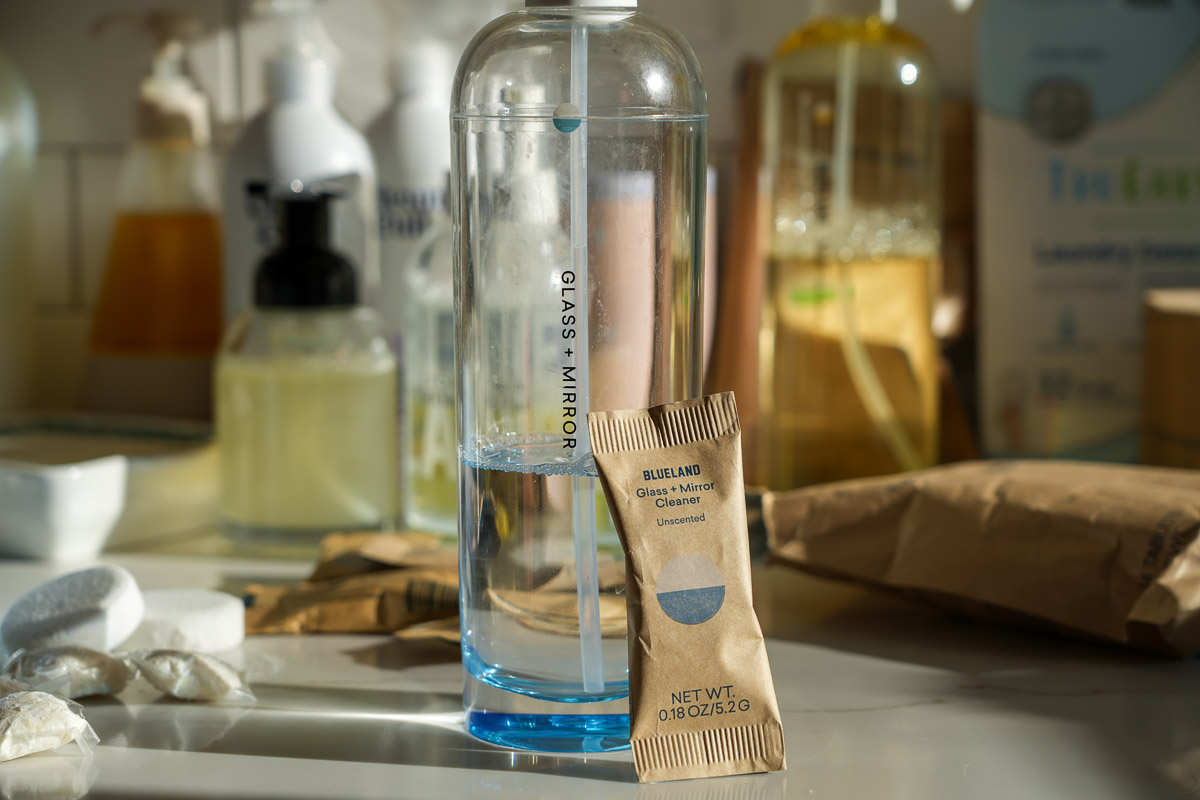
How it started
When I first tested Blueland in 2020, they offered just four products, all in a dehydrated tablet format: Hand wash, glass cleaner, multi-surface cleaner, and bathroom cleaner – so I ordered them all. I wasn’t the only one who had issues with Blueland’s “forever” bottles leaking and breaking, but their refills were genuinely zero-waste cleaning tablets that you dropped into a bottle of water. Excellent concept, but there was work to be done.
At the time, I also liked Cleancult’s refillable, non-toxic cleaning products – but I never liked the TetraPak they put their liquid refills in. Those packages are made of layers of plastic, metal and cardboard, and almost never recyclable. But their frosted glass bottles were beautiful and sturdy (even though the pumps on mine always clogged every 3 squeezes).
How it’s going (the Cleancult disappointment)
Fast-forward to 2025, and the one thing Cleancult hasn’t changed is the worst thing they do – those “milk carton” style refills. Sure, they use less plastic than new bottles of Clorox (or whatever grocery store brand in plastic). But that’s just not impressive anymore. The bar has been raised by brands like Blueland and Dropps. We can do better now.
What’s more, Cleancult has cut most of their sustainability initiatives:
Their screw tops used to be made of plant-based bioplastic. And if your local recycling program didn’t accept cartons (most don’t) all Cleancult packaging used to be recyclable through a mail-in program. But in 2025, I can’t find any references to either of these sustainability efforts on the Cleancult website.
Instead, they are now certified Plastic Neutral and help support other organizations cleaning up plastic waste. That would be lovely if they had taken care of their own wasteful packaging first.
[Related: I wrote more about the problems with mail-in recycling programs in a separate post. And plastic offsetting is a lot like carbon offsetting – it can be good if it’s done well, but it’s far less of a good thing than reducing the emissions and waste in the first place.]
Instead of improving packaging, Clean Cult seems to have mostly just expanded their sales channels (you can find Cleancult products in lots of grocery store chains now) without making any of the sustainability upgrades I’ve wanted to see from them for years.
Yes, it’s great to see a better than average brand making its way into very “business as usual” stores, but if you’re reading this, you know we can do better than what Cleancult offers.
[Related: If you’re curious about the choice between buying local – even it’s a worse product – and ordering something more sustainable, stay tuned for an article on that topic. ]
Also, Cleancult’s dispenser bottles used to be sturdy, pretty glass (as you can see below) and their products were thicker and foamier. They’ve changed the formulas a couple of times since I originally tested them in 2020. Then they replaced their original, frosted glass bottles with aluminum ones (that still have plastic lids).
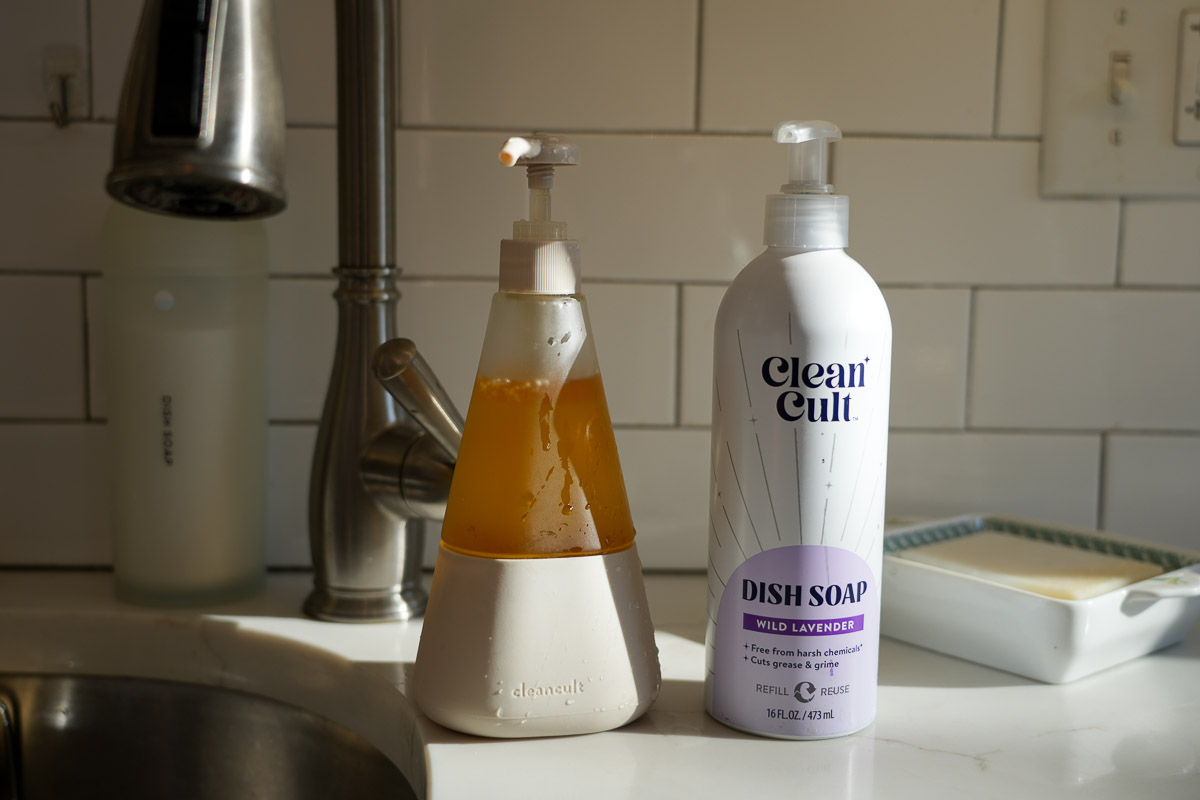
Blueland in 2025
Meanwhile, Blueland has become a certified B Corp – no small feat. That means they’ve been tested by a third-party for social and environmental sustainability, and have passed. (With solid score of 110, no less. The minimum for certification is 80, the highest score is 200.) In short, it’s a good sign that they’re continuing to innovate.
And they’ve added many more products – all of which are still dehydrated tablets (low shipping weight = less emissions) and use the most sustainable packaging I’ve found for any kind of consumer products, cleaning or otherwise.
(They’ve mostly stuck to cleaning, but they now also make a powder-to-gel body wash now that I really like.)
Blueland Bottles: Stronger than before
Back in 2020, in the first version of this review, I was about to finish this review with the following paragraph:
I haven’t personally had any problems, but some reviews mention the Blueland bottles breaking. Problems are probably few and far between, but the whole point is to avoid cheap things that break and have to be replaced.
But then – literally the day I was ready to publish – my husband picked up one of the spray bottles, and it cracked apart, exactly as I’d seen in another review. I guess problems being “few and far between” was wishful thinking.
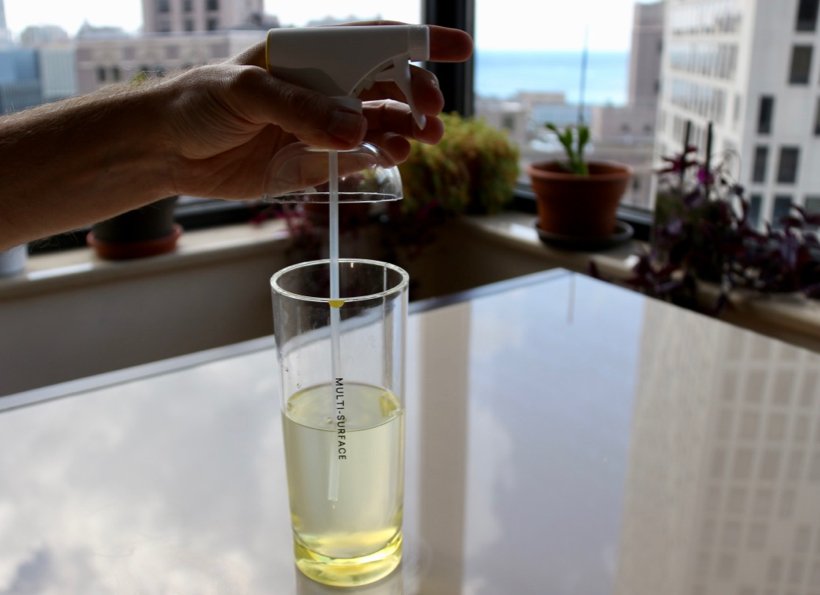
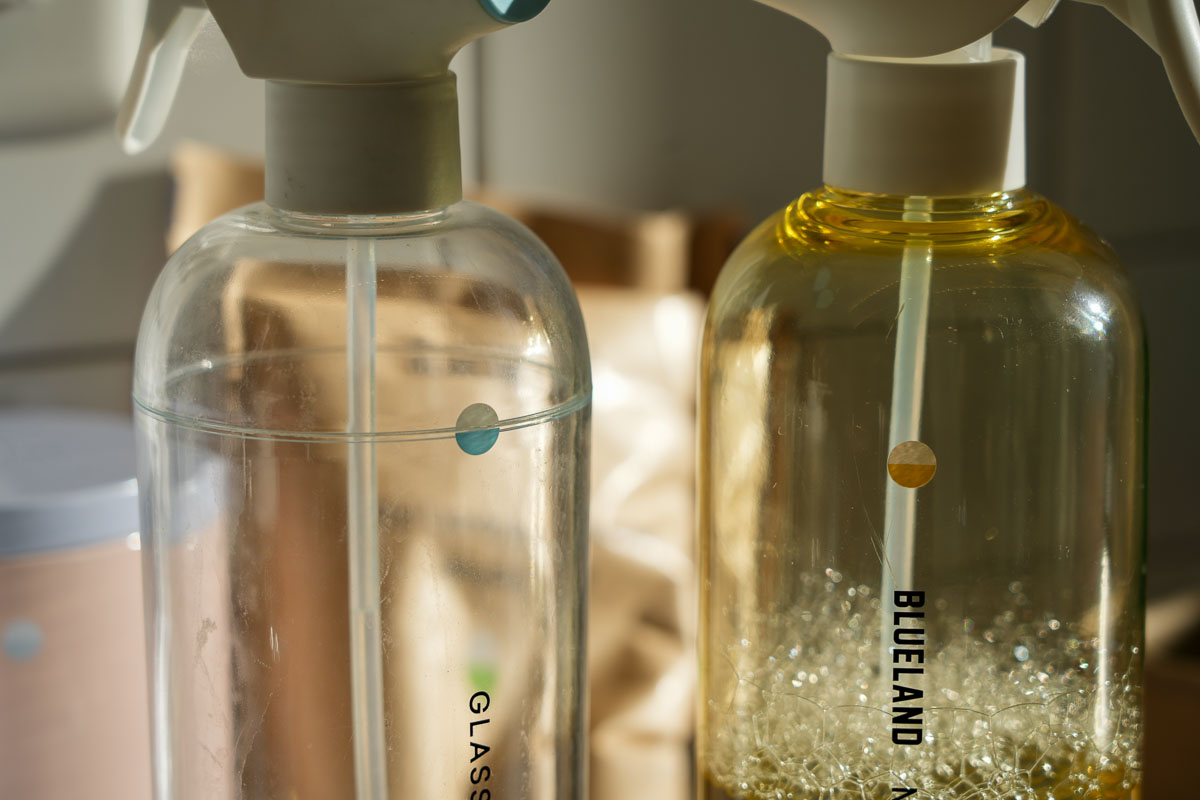

Sustainability Comparison: Blueland vs Cleancult
Like most comparisons in sustainability, which company is better depends on what you’re measuring:
Animals
Both brands are cruelty-free and don’t test on animals (they’re both Leaping Bunny certified).
Blueland’s ingredients are also certified 100% vegan, while Cleancult doesn’t specify (which is unusual for a supposedly sustainability-focused company).
Climate
Circa 2020, Cleancult used to advertise carbon-neutral shipping via offsets through a partnership with CarbonFund. But I can’t find any mention of that anymore.
Blueland has gone the opposite direction: When I first tested them in 2020, they didn’t participate in any kind of carbon offset program, or have much info about their emissions.
Although from the start, Blueland’s light-weight products have always meant fewer emissions from shipping. And reducing emissions is always the most important step to look for before a brand talks about offsetting them. (As I’ve also written about for travel.)
In 2025, they’re certified Climate Neutral and they’ve measured, reduced and offset all remaining emissions from every phase of their production. If you want to read an example of what we should always be looking for when a company mentions emissions reductions or offsets, click here and go the section “Climate Neutral.”
Ingredients
Blueland’s ingredients are EWG Verified – a third-party check on ingredient safety. They also have the USDA BioPreferred, EPA Safer Choice, and the Platinum Material Health Certificate from Cradle to Cradle, which “ensures the chemicals and materials used have been selected to prioritize the protection of human health and the environment.”
Cleancult doesn’t have any ingredient certifications that I could find. Their laundry detergent sheets contain PVA, which I’ve learned a lot about while researching plastic-free cleaning products. (It’s not as big of a concern as plastic packaging.) But if you want to avoid PVA, Blueland’s tablets are all PVA-free.
Refills & Packaging
Blueland’s dehydrated refill tablets come in tiny paper wrappers that are both home compostable and recyclable. And if they do end up in a landfill? Blueland’s packaging is just a lot less than any other option, which matters way more than recyclability.
[Tip for apartment composters: I put my Blueland wrappers in my Lomi home composter machine, and they disappear pretty well.]
Cleancult ships liquid refills – meaning they ship heavy water, instead of lightweight, concentrated tablets like Blueland. It would be hard to argue that shipping all that extra water weight isn’t just a waste. And the Cleancult refills come in cartons, which contain plastic and are NOT recyclable everywhere.
This is actually a huge point of frustration for me. Cleancult goes out of their way to advertise that their “paper-based” refill cartons are recyclable, and it’s simply misleading.
The problem with refill cartons
First, the cartons are not just paper, they’re Tetra Pak – made of layers of paper, aluminum and plastic.
Yes, they are technically recyclable, but most recycling facilities don’t have the equipment to deal with those layers, which means they’re not actually very recyclable.
And remember, Cleancult cancelled the mail-in recycling program they used to offer. But they still tell you this on their FAQ page: (Basically, “figure it out yourself.”)

And even if you do live in a place where the Cleancult cartons are recyclable, RECYCLING IS NOT THE SOLUTION. It should be the backup plan – just for the waste we can’t eliminate. But when it comes to cleaning products, we can eliminate the waste. Just buy Blueland instead of Cleancult.

Shipping Materials
Blueland and Cleancult both ship in plastic-free, recyclable paper and cardboard packaging.
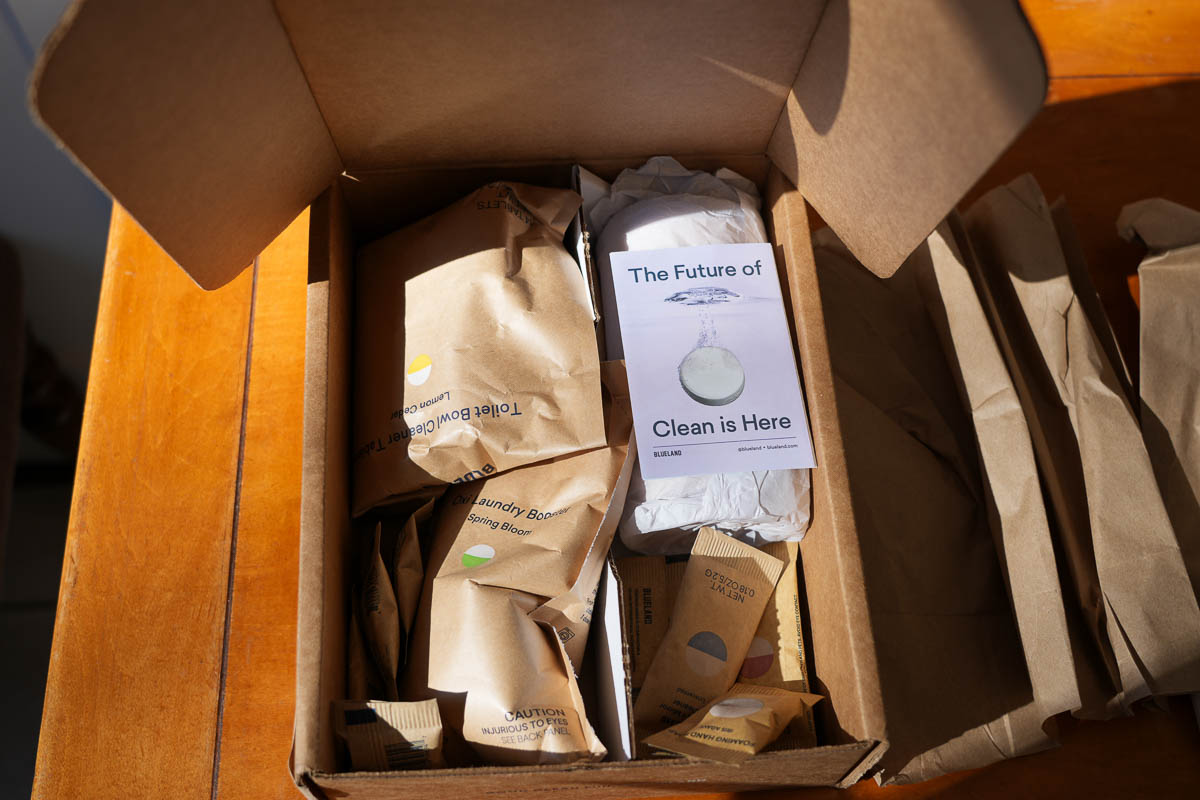
Cleancult on Amazon
I’ll confess that for this updated review, I actually ordered Cleancult on Amazon. I normally avoid Amazon whenever possible, but I was leaving for a trip and wanted to get the products ASAP to publish this. And I have to admit that I was, for once, not totally annoyed with Amazon’s packaging.
The Cleancult items all came without plastic packaging. Each item was individually boxed in it’s own cardboard box with paper padding, which seemed excessive, but at least there was no plastic.
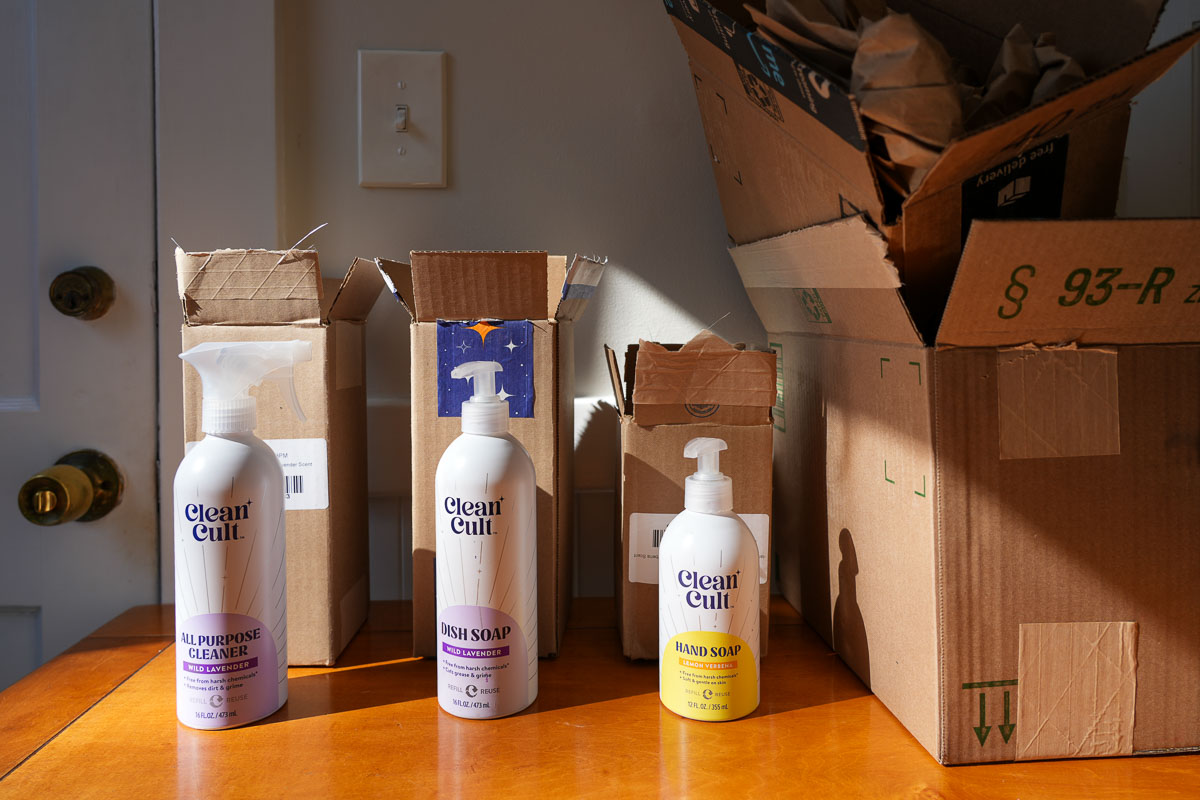
Normally, when you order a product from Amazon, the fulfillment and boxing are done by Amazon, which means even a more sustainable brand will likely be shipped in plastic. So I was surprised to see this.
I still strongly recommend shopping small whenever possible (so support the brands that are actually driving the sustainable innovation, not just the one that’s profiting off of being too big to avoid) but I have to give credit where it’s due.
Bottom line
With either brand, you reduce a repetitive source of plastic waste from your life – one you probably won’t miss. Both are better than business as usual, but we have a clear winner: Blueland beats Cleancult in every sustainability contest.

How to choose between Blueland and Cleancult?
Look, I’ll put it bluntly: Just start with Blueland, because it’s clearly the more sustainable option, and if you don’t like it, or don’t like some of the products, try that product from Dropps (for laundry and dishwasher tablets) or from Canary (for hand soap).
Use Cleancult as a last resort if you want more natural ingredients than what you can buy in the grocery store – but know that you’re not getting more sustainable packaging.
Better is better than perfect, so find what you’ll stick with – without going back to buying products in new plastic bottles every time you run out.

Shopping Comparison: Cleancult vs Blueland
Prices & Shipping
Blueland ships to the US, Canada, UK, New Zealand and Australia. They offer free shipping on orders over $50 for US orders.
Blueland costs a bit more to get started, but then costs less over time with refills that are about $2.25 each (depending on how many you buy at a time).
If you buy just one kind of cleaner, the initial bottle and two tablets cost $16. (With a subscription, the initial order costs less, and if you’re planning to buy more than one product, there are lots of starter kit options that save a lot of money. Either way, it’s cheaper than buying normal Clorox and Windex at the store.)
Reuse-What-You-Have Tip: You can also just buy the Blueland refills and put them in a bottle you already own. Their hand wash tablets, for example, are designed to work in any 9 oz. foaming hand wash bottle. (I’m going to test this, so stay tuned for a video.)
Cleancult ships only to the US and most US territories. (Puerto Rico, Guam, the US Virgin Islands, and Saipan.) Limited geography is good thing here, considering all the water weight they’re shipping.
Cleancult products cost about $6 for the initial aluminum bottles. Tetrapaks with enough liquid for two refills costs $9. (So $4.50 each refill – twice the price of Blueland.)
See my chart below below for all of the laundry and dishwasher tablet prices.
Scents:
Blueland’s scents are subtle, but I do find them a bit artificial smelling. Not terrible, just not super exciting.
Their glass and mirror cleaner, dish soap, and dishwasher tabs are unscented. The other cleaning sprays have fragrance. The Blueland hand soap comes in multiple scents (including seasonal options) and fragrance-free.
Most Cleancult products are scented with essential oils, which makes them smell very good – and very strong. The scents linger on my hands for a while after washing with their hand soap or dish soap.
(Their liquid laundry soap comes in a fragrance-free option. Otherwise, all Cleancult products are scented and they have been forever. They’ve always said they were thinking about unscented versions, but have never done it, so I wouldn’t hold my breath if you’re looking for fragrance-free.)
A Mrs. Meyers Scent Dupe?
But this is one area where Cleancult wins me over – their Wild Lavender scent instantly reminds me of Mrs Meyers’ Lavender scent. I thought maybe it was just me who felt super nostalgic about this scent (it was the “fancy” hand soap my roommate and I used to spring for in college). But actually a few of you of you have emailed me asking about a plastic-free Mrs Meyers dupe!
I guess I found the scent, but not the plastic-free part. I’ll keep trying.
I wish it weren’t Cleancult, since I’m so unimpressed with their sustainability efforts overall, but if you love that nostalgic scent, at least this gives you an aluminum bottle option for it.
How to Order:
Blueland is now on Amazon (they weren’t in the beginning). Or you can order Blueland directly through their website.
Cleancult has been available on Amazon since the beginning, or directly through the Cleancult website.

Hand Soap Review: Cleancult vs Blueland vs Canary
Cleancult hand soap comes in two styles: their original gel hand soap, and a foaming formula (which I suspect will be discontinued soon, because they’re not selling the foaming bottle anymore).
The gel kind lathers more richly than the Blueland foaming hand soap (which comes with tablet refills). But I find Cleancult’s new formula more drying on my skin than their formula used to be. It’s also easy to use too much – a full pump from the aluminum bottle gives you more than you need.
Plus, for it being a refillable pump bottle that you’re meant to keep around forever, Cleancult’s liquid hand soap bottle is not very pretty. Blueland’s glass bottle is definitely an easier one to commit to.
Refill Tip: If your Blueland pump goes kaput, they’ll sell you a replacement part – no bottle, just the pump! Fixable, the way things should be. (I’ve had mind since 2021 and it’s still going strong.)
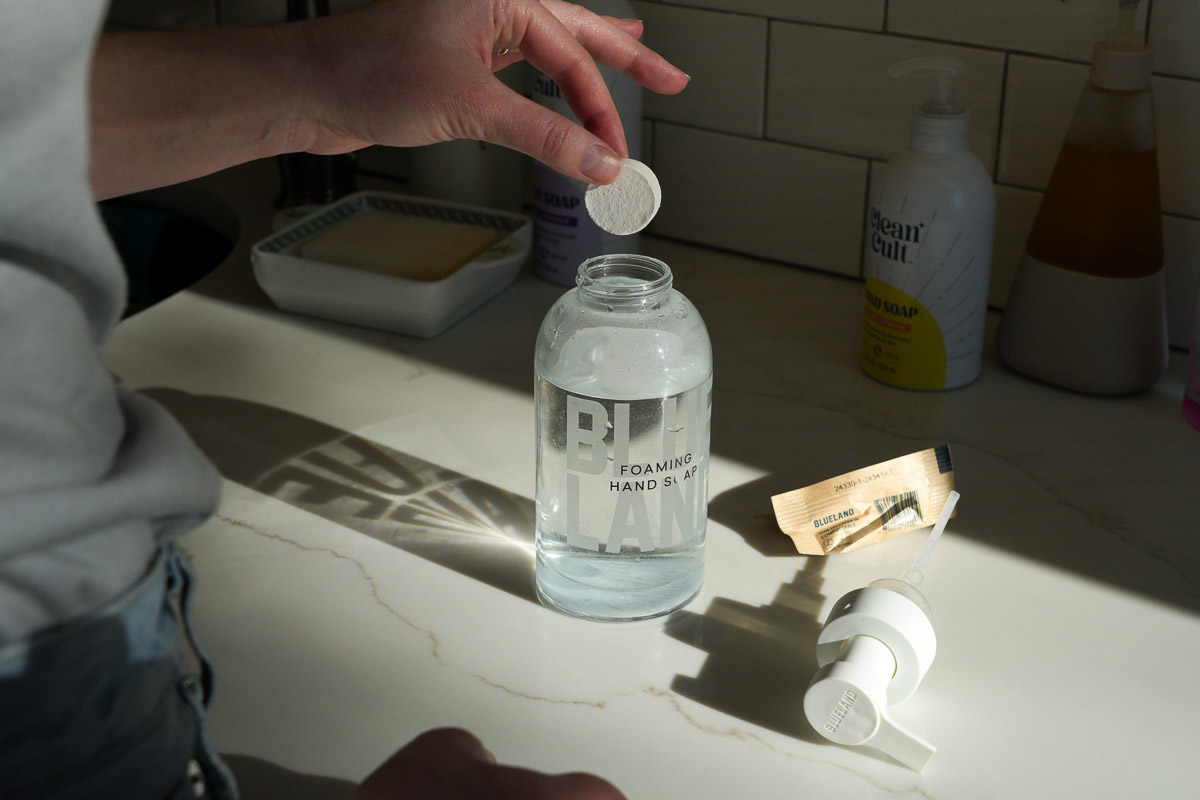
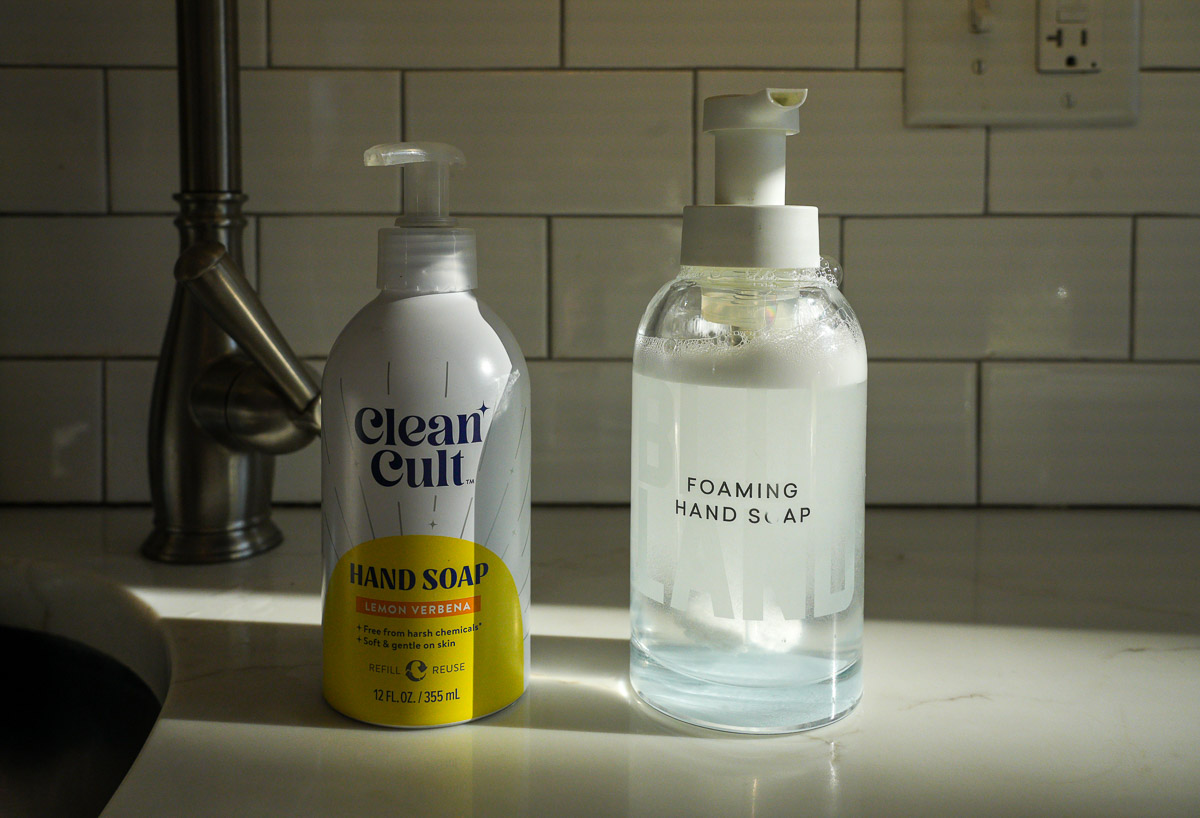
(As for Cleancult’s foaming hand soap, their website shows pictures of the special bottles you would refill… but no way to buy them. They’re not listed as out of stock, they’re just not listed at all, including on their Amazon store. It’s a bit bizarre. I’ll update this here if I learn anything.)

Luckily, I tested mixing & matching other hand soap refills in the video below…
Blueland Foaming Hand Soap test
After trying almost everything from both brands, Blueland’s foaming hand soap is one of their products I recommend without reservation.
That being said, the only complaint I’ve heard is that it takes 2 to 4 pumps of soap to get a good lather (two is enough for me, four for my husband, who apparently has big, dirty hands).
That might seem like a lot, but it’s not such a big deal when you consider that each 9 oz Blueland refill costs $2.50 or less (way less than a bottle of soap at the store, or a Cleancult refill). And you’re not throwing away the bottle. So go ahead, pump a few more times.
(And $2.50 is the non-subscription price; they’re $2.25 if you do subscribe.)
Canary Foaming Hand Soap
And that brings me to another alternative: Canary’s foaming hand soap, which I have to say, I agree with my husband on this one: It’s foamier! Blueland is still great, but I think Canary is just a step better.
In case you already have a foaming hand soap bottle (from Blueland or another brand), I decided to do a little test to see if the refills are really interchangeable, as Blueland claims.
You can watch it here:
Can’t beat a classic: Still, the closest you’ll get to “zero” waste hand soap is an old-fashioned bar of soap (as long it’s not in plastic packaging). I love these bars, from one my favorite shampoo bar brands. (Cleancult used to make a bar soap, circa 2021, but they discontinued it years ago.)
Hand Soap Scents:
Blueland hand soap comes in many scents – including fragrance-free, which, as of 2025, Cleancult still doesn’t offer. Blueland also rolls out unique seasonal scents regularly.
Canary makes several scents, from Bourbon Reserve to Citrus Grove. I have their Cedar Mint scent, and it’s very light. As soon as I dry my hands, I don’t really notice the scent anymore. Same goes for Blueland.
Cleancult is the only hand soap I tested with really strong, lasting scents. They currently make three of them.

Cleaning Sprays: Cleancult vs Blueland
I’ve tested Blueland’s bathroom cleaner spray vs their multi-surface surface, and honestly I can really tell the difference. (Maybe I’m not enough of a cleaning expert, which would not be surprising. But let’s just say that for basic use, the multi-surface cleaner might be all you need.)
I used to prefer the Cleancult all-purpose cleaner, but I don’t think it’s as good as it used to be. (Or else Blueland has improved in this department, too.) They both work well. As usual, Cleancult leaves more of a scent behind.
Only Blueland makes a refillable window cleaner. It works really well, doesn’t leave streaks, and the refills are way cheaper than buying bottles of Windex!
If you want to use a bottle you already have at home, Blueland is the way to go because the product isn’t as thick, so it’s more likely to work in more bottles. (Just make sure you use the right amount of water for the tablet.)
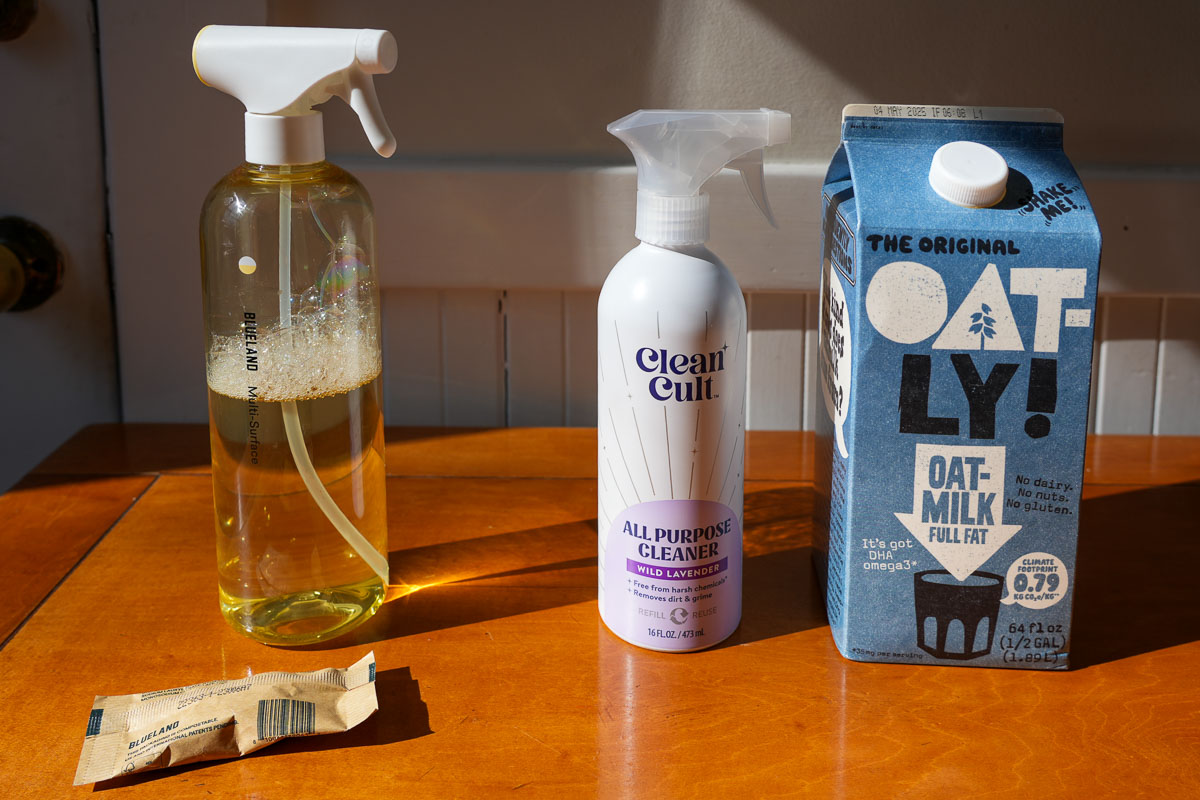
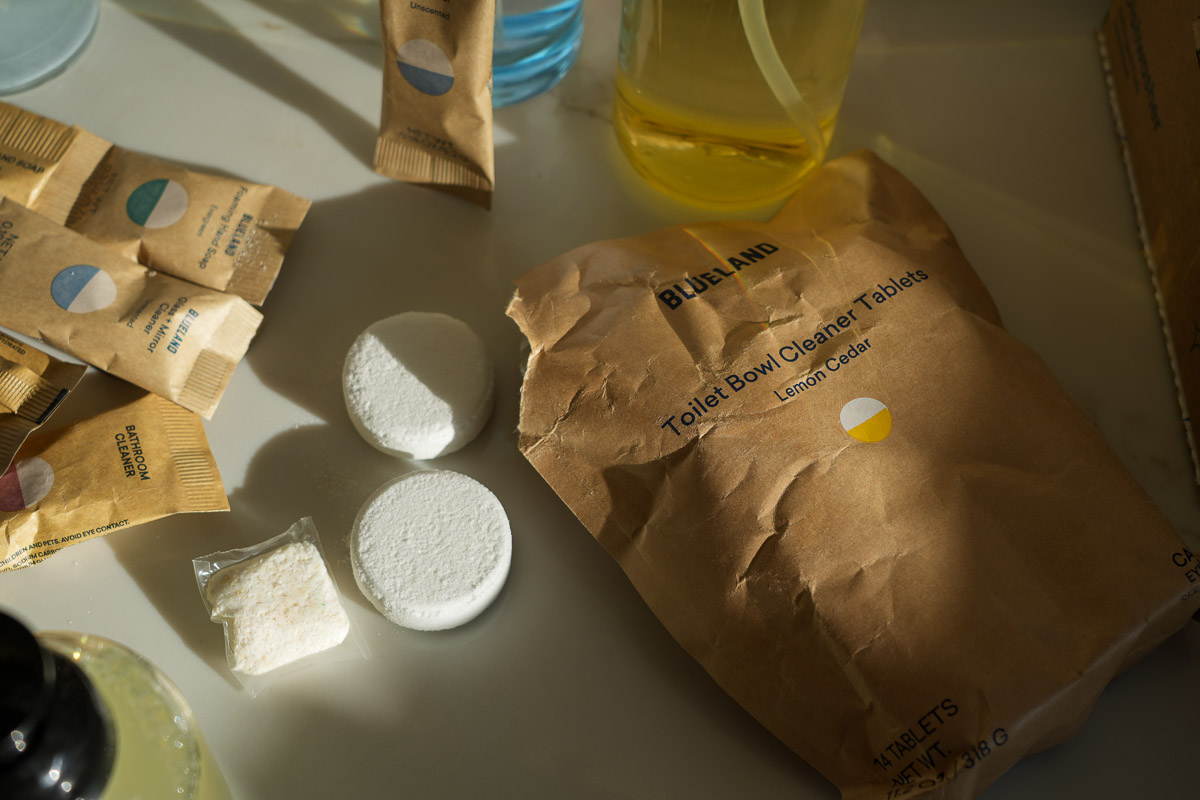

Dishwasher Tablets Review: Cleancult vs Blueland vs Dropps
Blueland, Cleancult, and Dropps all make their own plastic-free dishwasher tablets.
Honestly, this is going to be a short review because I tried them all, and all three options worked perfectly well. I’ve gone through entire orders of each, inspecting my dishes and looking for some significant difference, and I literally can’t tell any difference in the results between the three brands.
(If you’re wondering why I’m I writing a review of cleaning products when I’m clearly no clean freak, well first of all – I CAN TELL WHEN A DISH IS CLEAN OR NOT. And secondly, most importantly, I am here for the plastic.)
Blueland’s tabs are fragrance-free and free of PVA. Cleancult’s are scented (which I can’t understand why you’d want). Dropps offers both scented and unscented options.
(For detailed, see my full Dropps review.)
My advice? Keep things simple and go with whichever brand you’re planning to order multiple products from. Minimizing shipments is an easy sustainability choice.
Personally, I’ve been reordering Dropps‘ and Blueland’s dishwasher tablets for years now, depending on what else I need to order at the same time. (I also use Dropps’ natural fabric softener pods and Blueland’s zero-waste cleaning tablets, so I try to consolidate orders.)
 Dropps
Dropps
Dropps are fantastic for low-waste laundry, dishwasher and fabric softener pods. Their detergents come in multiple scents and lots of varieties, all in plastic-free packaging.

Eco-Friendly Dish Soap: Cleancult vs Blueland vs No Tox Life
For washing dishes by hand, I’ve tested three, or… 2 1/2, plastic-free dish soap options:
- Blueland makes a fragrance-free dish soap powder,
- Cleancult’s is a heavily-scented liquid dish soap,
- and No Tox Life makes a solid dish soap block.
Don’t expect any of them to suds quite like normal dish soap – because they don’t use SLS (sodium lauryl sulfate). SLS is a known skin irritant that’s in tons of products because it helps with foaming but not with actual cleaning. (There’s more about SLS at the beginning of my very first shampoo bar review, too.)
No Tox Life Solid Dish Soap Review
Probably the best dish soap option I’ve tried is the solid detergent and plastic-free dish brush from No Tox Life. On the low-waste scale, this system is pretty much unbeatable.
First, the dish “block” (a block of solid, vegan dish soap) comes in a simple recyclable cardboard box. The company is owned by its original founders – a mother-daughter team. They manufacture their products in a solar powered factory in the US.
The Dish Block doesn’t come with any real packaging beyond it’s cardboard box – just put it in your own bowl or tray. (Or they do make a bamboo soap “shelf” – but note that’s open on the bottom.)
The head on their dish brush is easily replaceable, so you never have to throw away the handle. Plus there’s no plastic involved – the brush is all natural wood and plant-based fibers. (But if you already have a plastic brush that works, or a stash of sponges, that’s fine! Just order the solid soap.)
Blueland Dish Soap Review
I’ve been through a multi-year saga with the various versions of Blueland’s powdered dish soap, but I think it’s now one of the best plastic-free versions available. It’s easy to use, unscented and cuts through everything I’ve ever had in my kitchen with ease.
A little backstory: It used to be a really fine powder that caused a lot of coughing, but that problem was mostly fixed years ago. I do occasionally notice a tiny tingle in my nose if the air is blowing the right direction when I use this product, but no more coughing fits.
That being said, if you are super sensitive and prone to coughing, sneezing, etc, or maybe have Asthma, it might be one to try with caution, or just go for the dish block.
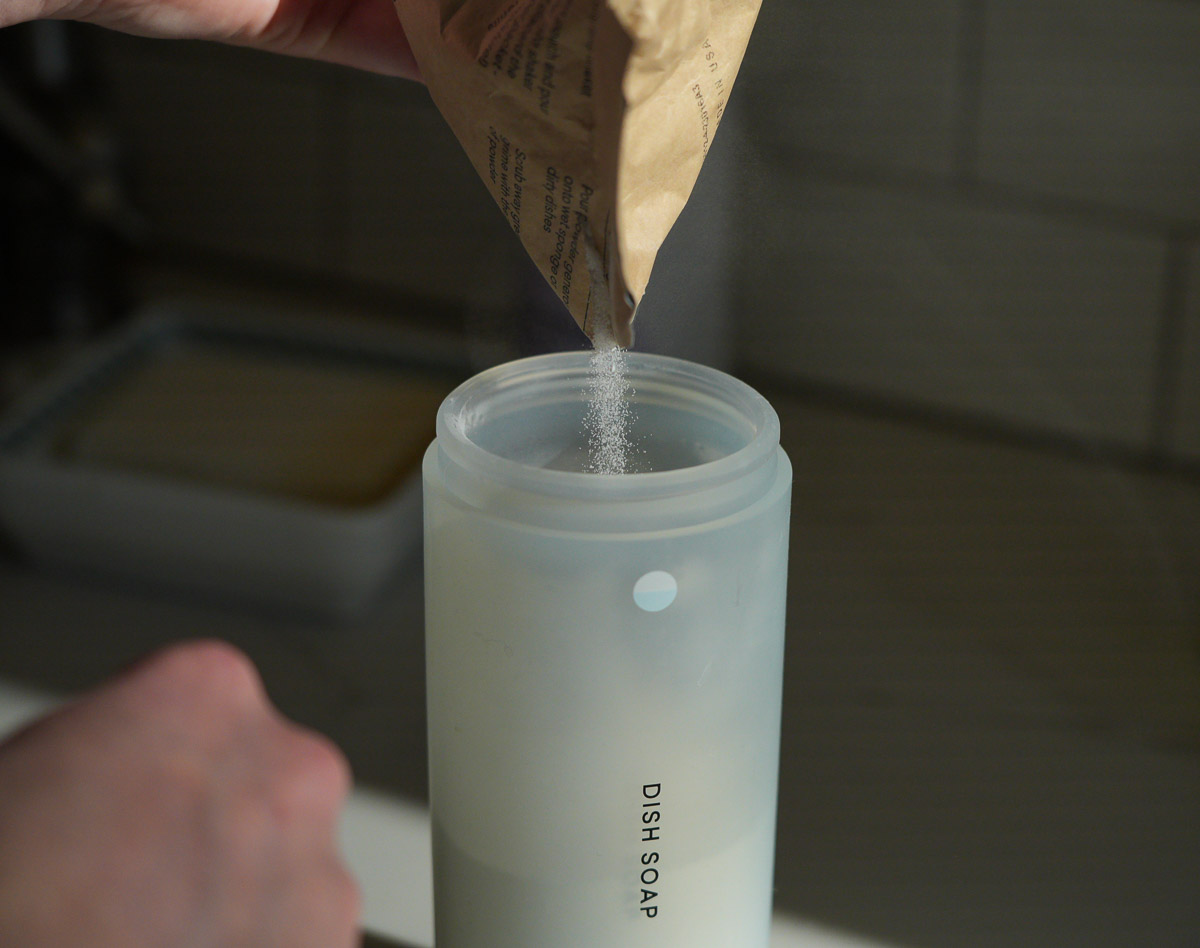
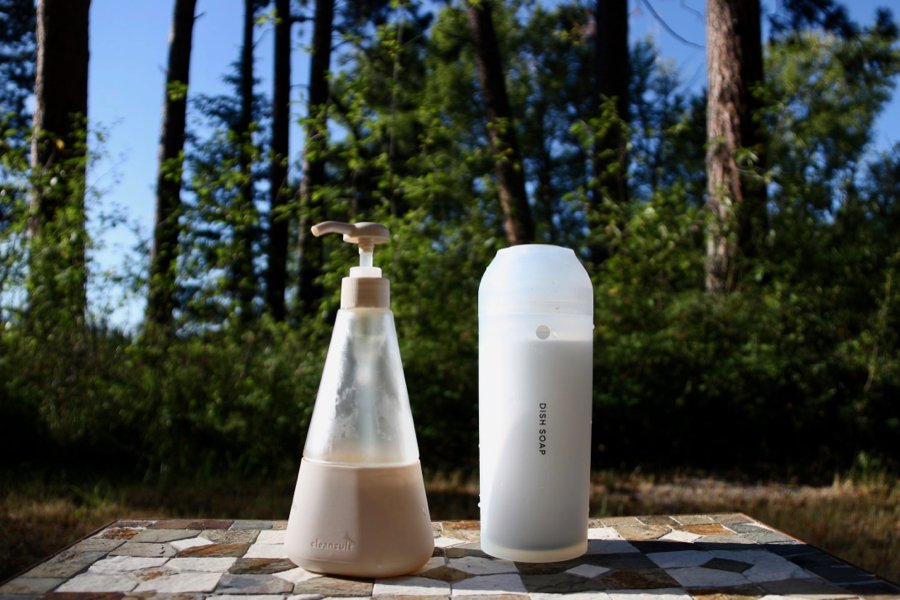
Cleancult Dish Soap Review
This liquid dish soap gets the job done, but but not fully plastic-free.
And it’s so strongly scented that I can smell it on my dishes (and my hands) after washing. I’m not sensitive to fragrance at all, and yet it still almost gives me a headache when I use it to wash even a few dishes. (They don’t make an unscented version.)
And of course, the emissions factor of shipping a product that’s mostly water instead of a powder or solid block, like the options above, makes it hard to make a case for this one.
If you love scented dishes, and have to have liquid dish soap, then Cleancult dish soap is probably more eco-friendly than standard dish soap brands, but definitely not as sustainable as Blueland or No Tox Life.

Packaging Comparison:
Blueland’s dish soap container is made of silicone and seems indestructible – I’ve been refilling mine for years, and design hasn’t changed because it hasn’t needed to. It’s not bad looking, either.
Tip: Or you could just order the Blueland dish powder refill and put it in an old spice shaker bottle.
I find Cleancult’s new aluminum bottles are boring and commercial looking – no better than your average bottle of Dawn or anything else.
In the long-run, No Tox Life’s dish block system is the most low-waste option. There’s no packaging besides a paperboard box (one of the most widely recyclable materials in the world) and you keep it in a dish you already have.
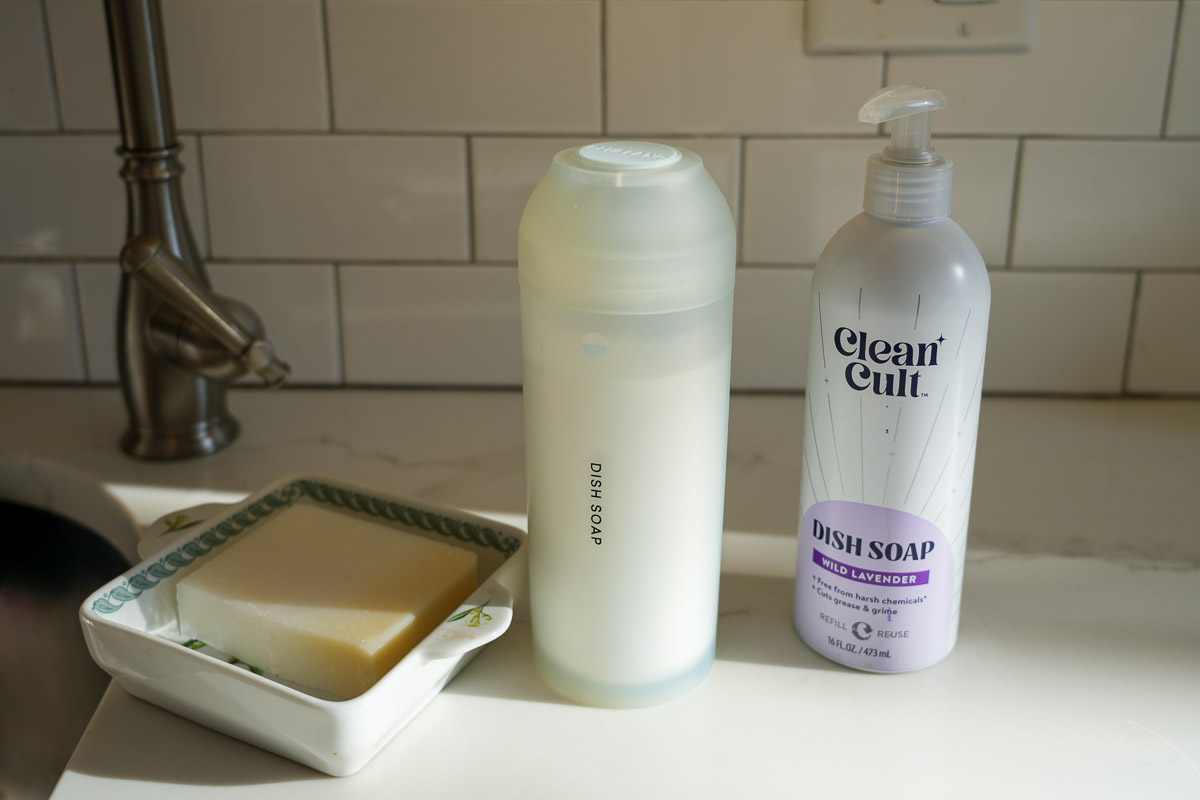

Laundry: Cleancult vs Blueland vs Dropps vs TruEarth
For plastic-free laundry detergent, I’ve tried five brands that all worked well:
- Blueland – 100% plastic-free laundry tablets and oxi-booster powder
- Dropps – detergent pods, and fabric softener pods. (For details: See my full review of Dropps pods here.)
- Cleancult – detergent strips and a liquid detergent in milk carton-like jug (not recyclable, unfortunately)
- TruEarth and Earth Breeze – strips. (For details: Here’s my laundry sheet review.)
As far as I could tell, they all worked just as well as normal liquid detergent.
Blueland has the best sustainability credentials, so I would normally just keep ordering from them.
But I’ve actually been reordering Dropps for a while, in the interest of shipping fewer packages. The reason is that I also like Dropps’ fabric softener (they’re the only plastic-free company I’ve found that makes one) and I like to keep Dropps detergent on hand for stains – I cut open the pods and use the liquid to pre-treat.
[For details, see my Dropps review.]
Blueland Laundry Tablets & Oxi Booster
Blueland makes fragrance-free laundry tablets, and they’re the only ones that don’t use PVA. (That’s polyvinyl alcohol – a controversial, though likely not harmful, ingredient, which I broke down in a separate post on PVA).
They work well, and if you’re looking for detergent that gives your laundry more scent, their oxibooster does a great job. (It’s the only laundry product I’ve tested that makes it so I can smell the clothes hanging on the drying rack when I walk by the room they’re in.)
Dryer Balls – what are they?
If you use a dryer, “dryer balls” do two things: Make clothes dry faster (saving energy) and replace fabric softener (saving plastic and money).
Cleancult has the lowest price for wool dryer balls. (They’re $10 for 3 from Cleancult, $18 for 3 from Blueland, or $29 for 4 at Dropps.)
But because I only rarely use a dryer (both to save energy, and to keep my clothes in better shape for longer) I also use Dropps’ fabric softener pods, below.
Fabric Softener That Works – Without Plastic
In addition to dryer balls, I also use Dropps’ fabric softener pods. They’re the only fabric softener I’ve found that doesn’t come in plastic packaging, and they work really well and smell great (although they don’t leave a very strong scent on clothes).
(For more info, check out my separate review of Dropps.)
Otherwise, Earth Breeze strips are the only plastic-free detergent I’ve found that makes clothes come out feeling like they had a bit of fabric soften in the wash with them.
[Full review of Earth Breeze laundry sheets.]
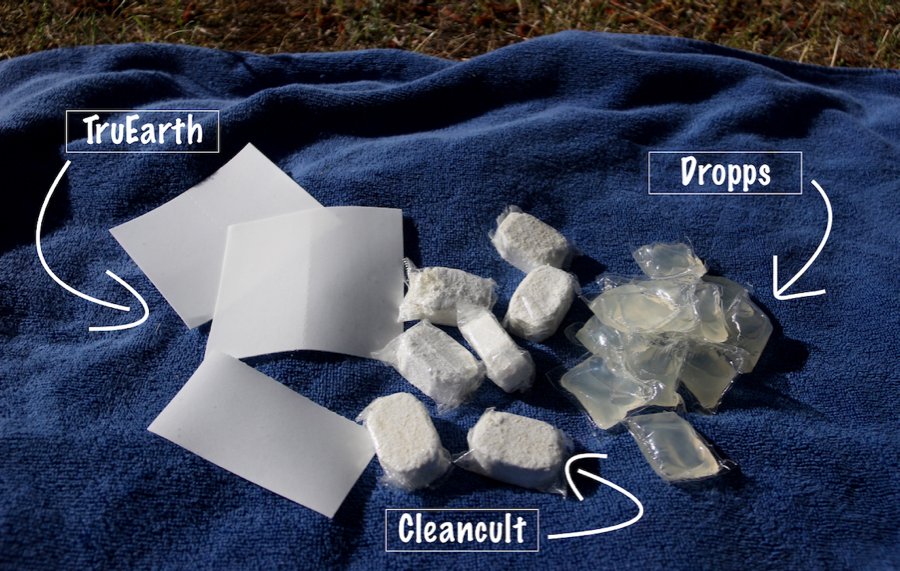

TruEarth Laundry Strips
This Canadian company makes plastic-free strips of concentrated laundry detergent that are one of the easiest of all zero-waste swaps. (And I’m not the only one who thinks so – TruEarth was listed as the second fastest growing start-up in Canada back in 2021.)
They’ve experimented with lots of other products over the years, but laundry strips are their flagship product – and as of 2025 they make a lot of different varieties and scents.
But since I first started using TruEarth, a better brand has come across my desk: Earth Breeze. In addition to having few questionable ingredients and costing much less, they donate to lots of causes and offset all carbon emissions.
[Details: My full review of TruEarth vs Earth Breeze detergents sheets.]
Sustainability:
Detergent in strip form has some of the most minimal packaging you can find: They arrive at your door in a cardboard envelope no bigger than a thick letter (with enough detergent for dozens of loads of laundry). It just has a shipping label on the outside. (TruEarth says they’re 94% lighter than an equivalent amount of liquid detergent.)
Plus, there are no parabens, phosphates, dyes or chlorine bleach. (But TruEarth doesn’t mention being free of phthalates, a known hormone disruptor, which is one of my reasons I switched to Earth Breeze.)
Like most eco-friendly laundry and dishwasher pods, TruEarth and Earth Breeze strips both contain PVA. But after a lot of research, I’m not convinced that’s a problem. We have bigger fish to fry (like plastic bottles) and not much real evidence that PVA is a problem.
Price:
The standard price for TruEarth strips is $21.95 for 32 strips (69¢ per strip), which is actually a lot. The subscription brings that down to $15.95, but it’s still more than Earth Breeze strips, which are 67¢ each – but you save another 40% with a subscription.
Where to order Laundry Strips:
You can order Earth Breeze directly from their website, or on Amazon.
Order TruEarth on Amazon, from EarthHero (the best sustainability-focused online retail shop I’ve found) or directly through their website.
 Earth Hero
Earth Hero
For any kind of sustainable products – toiletries, yoga pants, tech, you name it – this Colorado-based start-up is my favorite shop. They have the best selection, and the best sustainability credentials compared with other online stores for sustainable products.
TruEarth products are also available in some brick-and-mortar zero-waste stores, and on Amazon.

Laundry & Dishwasher Detergent Comparison Chart
| TruEarth* Eco Strips | Cleancult* dishwasher tabs | Blueland laundry detergent tablets | Dropps* dish & laundry pods | |
| Sustainability Certifications | B Corp – score 82. (alternative Earth Breeze has a higher score & other pros – review soon) | Plastic Neutral | B Corp – score 110. Climate Neutral. EWG Verified. Leaping Bunny. + Many More! | B Corp – score 90. Carbon offset through ClearLoop. Leaping Bunny. + More! |
| Price | $16.95 for 32 strips | $11.72 for 32 | $21 for 60 | $22 – $29 for 64 pods |
| Price each | 69¢ | 37¢ | 35¢ | 0.34¢ to 0.45¢ |
| Subscription price each | 45¢ | 35¢ (5% off) | 32¢ (subscribe OR buy bulk to save 10%) | 30¢ to 32¢ (subscribe to save 25% AND 5 – 10% for bulk orders AND use the codes below) |
| Discount Code | TILTEDMAP10 = 10% off when ordered from EarthHero | N/A | N/A | TILTED25 = 25% off 1st order AND TILTED15 = 15% off repeat orders |
| Subscription frequency | 1, 2 or 3 months direct. Anywhere from 1 – 9 months from Earth Hero | 1, 2, 3, 4, 5 or 6 months | 3 months | 1 – 12 months (starts at 3 months, but you can change this is in your account) |
| Shipping | Depends | Free over $40 (ships to US & territories only) | Free over $50 in US (also ships to Canada, UK, NZ, AU) | Free over $35 (ships to US only) |
| Scents | Many, including fragrance free | Multiple – almost no fragrance free options | Scented OR fragrance free | Many – all products come in unscented, too |
| Review for Details: | Earth Breeze vs Tru Earth Review | Cleancult Review | Blueland Review | Dropps Review |

Pin this Cleancult vs Blueland review for later!
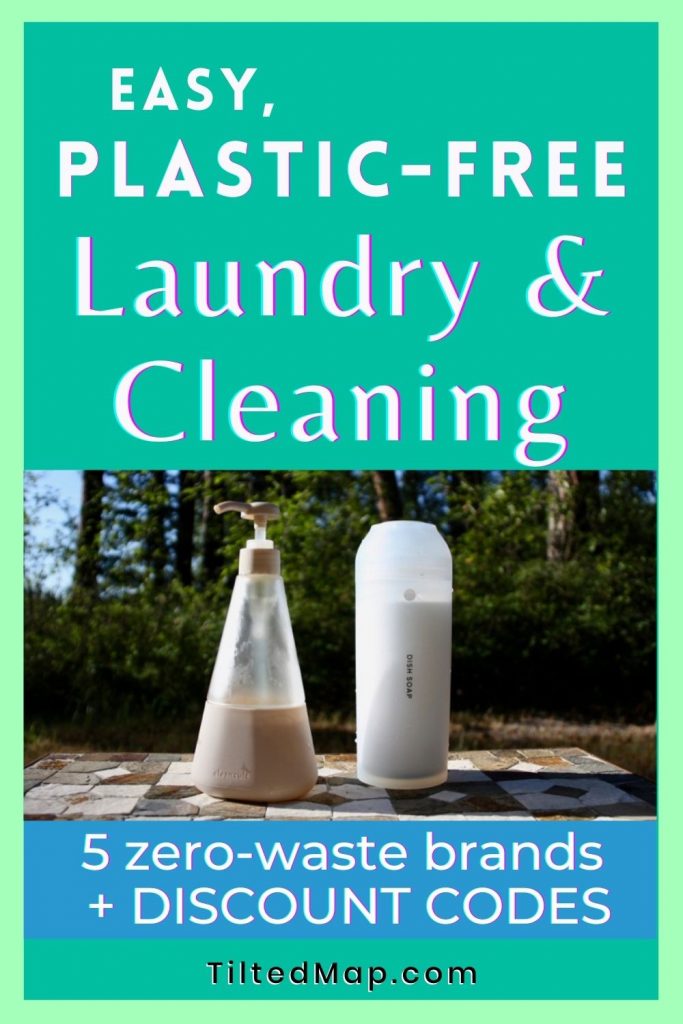
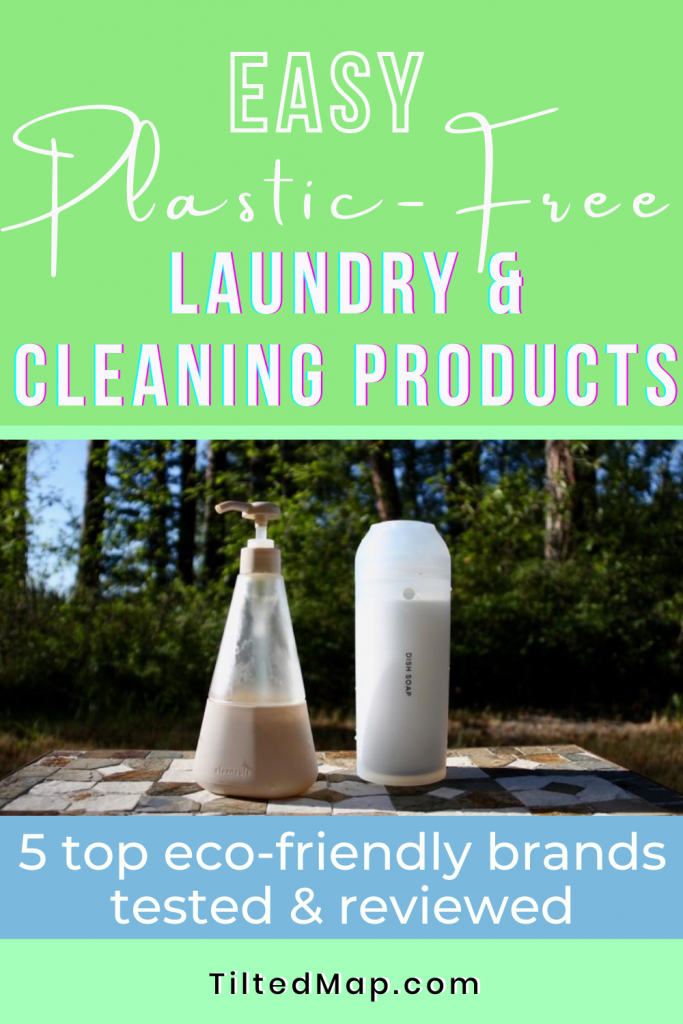

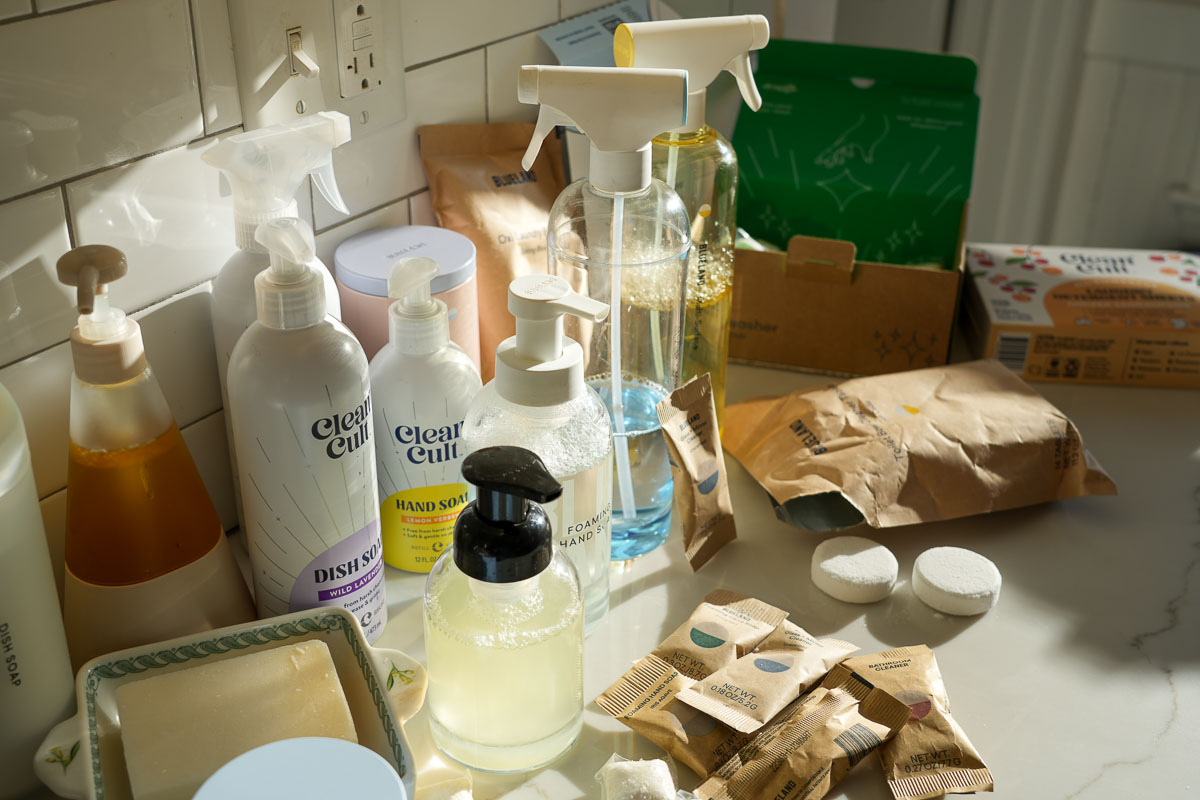
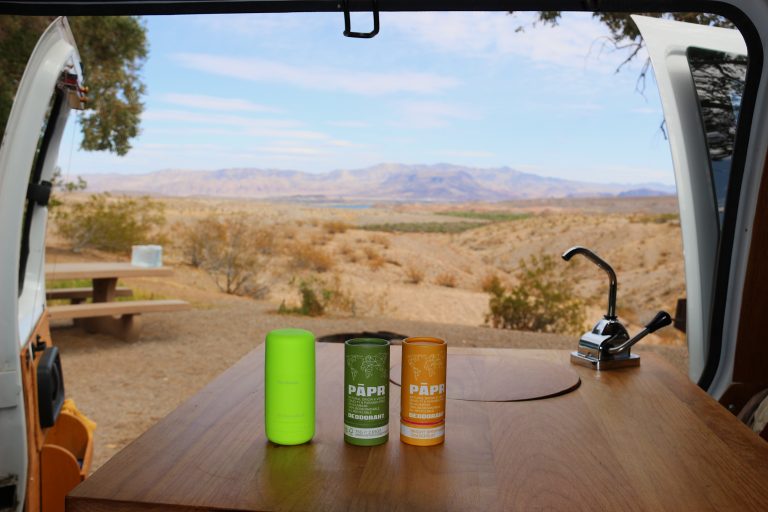
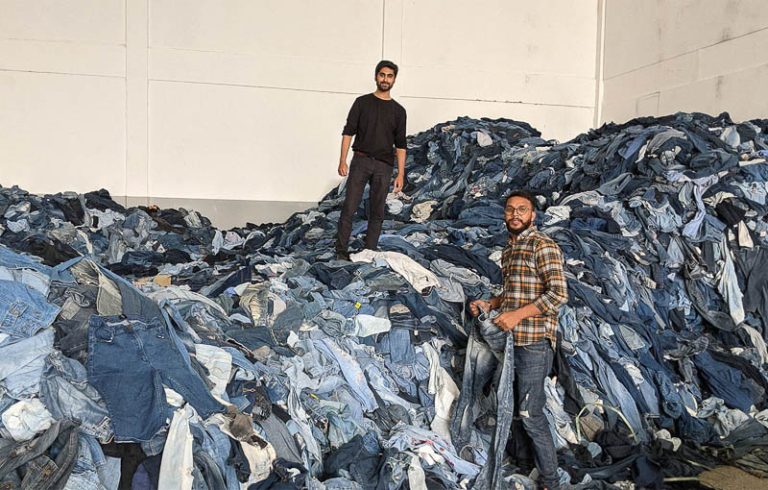
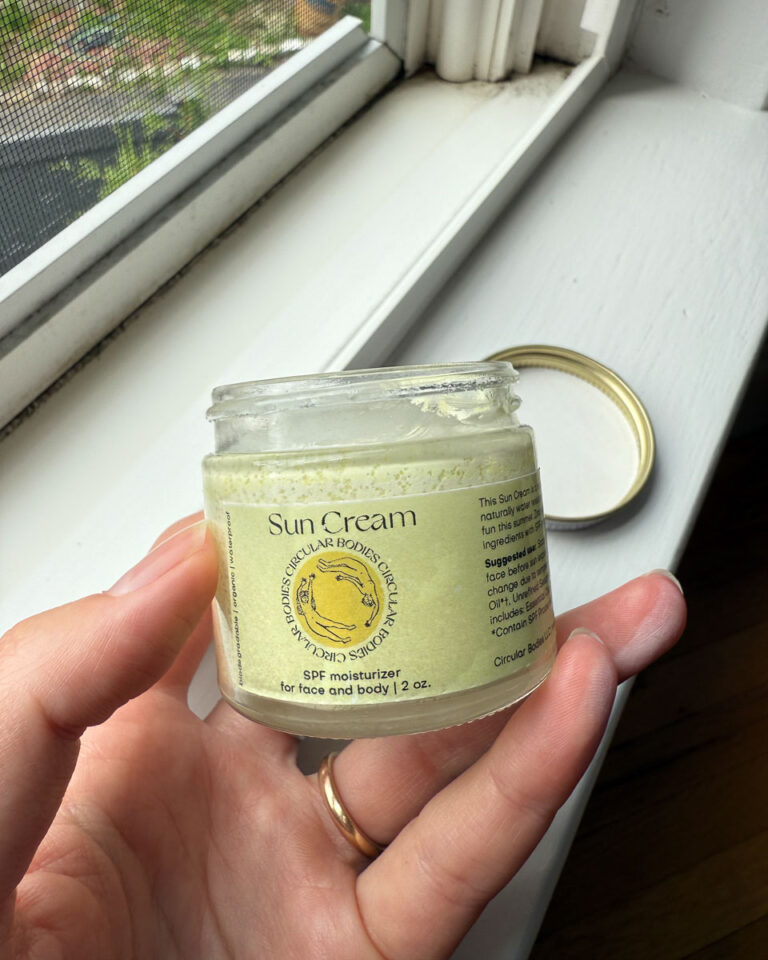
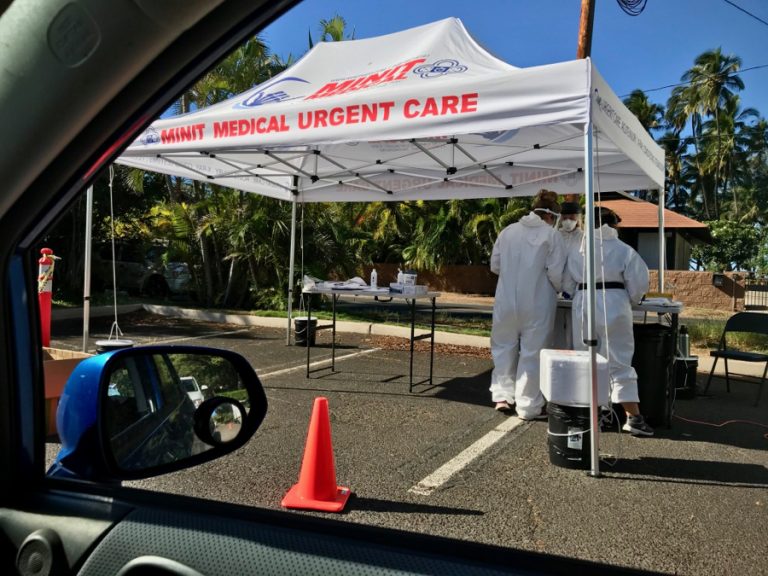
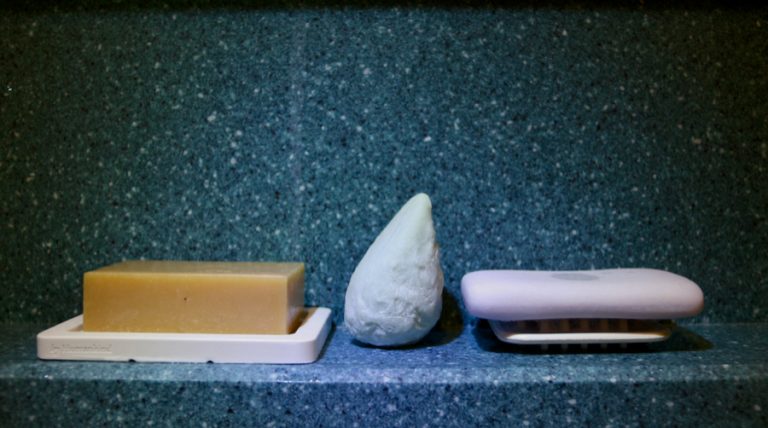
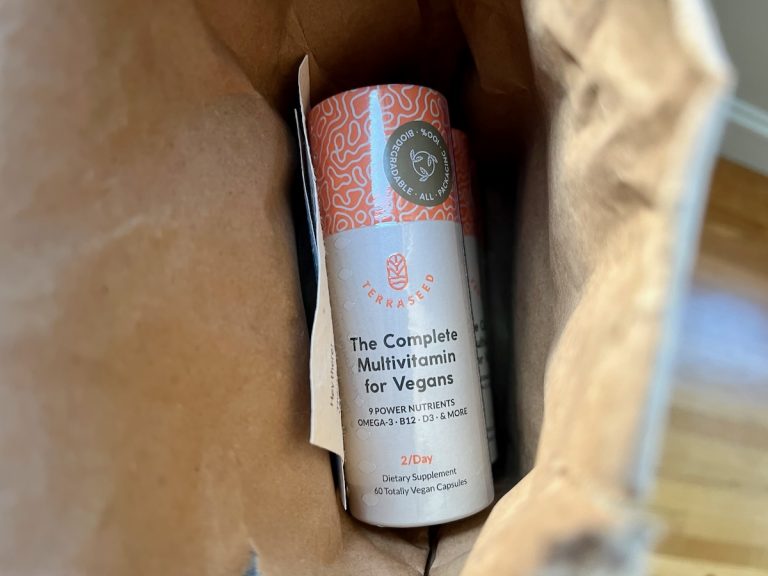
Love this! Thank you so much! I’ve been looking to make the switch when all my current products run out and was having a hard time deciding which options were the best for us. I’m excited to try some of these out and see how they go. Thank you for such a thorough and in depth review 🙂
Hi Samantha,
Thank you! So glad to hear you found it useful! 🙂 Like you said, there’s a lot of info to dig through when you start comparing these brands in detail, so I thought it would be useful to lay it all out, side-by-side.
If you have questions about random details on any of these, let me know!
Ketti
PS: I dig the name of your blog! “Curious” is one of my favorite personal descriptors. 🙂
Thanks! It’s been fun to get into blogging. And I’ll definitely reach out if I have more questions 🙂
Sam
Thank you so much for such a detailed review of these products. For a while, I have been debating on which brand to choose from. I was mainly convinced with Blueland’s prices and efficient packaging. But I loved the fact that Cleancult contributes to Puerto Rico’s –my home country– economy. Now that I know Cleancult has more efficient products and is constantly innovating their business, I will definitely go with them.
Hey Alejandra,
You’re welcome! Happy to help. 🙂 It’s definitely cool how much work Cleancult does in Puerto Rico – and it seems to be a lot of high-level corporate positions, too, which is great. (They actually have entire Puerto Rico FAQ page about their business and involvement there, in case you hadn’t seen it.)
Thanks for your comment and keep in touch!
Cheers,
Ketti
Thanks so much for sharing all of your research! I just found your blog and have really enjoyed it. I have ordered a few of the toiletry products you recommended to try out.
I also have a question related to this post. Recently I came across micro-fiber-filtering laundry balls. Cora balls are the brand I first saw. Have you tried these or know anything of them? Thanks!
Hi Erica,
Thank you! I’m so happy to hear you appreciate the research! 😊 It’s become a bit of an obsession for me, so there’ll certainly be more reviews coming.
I’ve heard of the Cora balls, but haven’t really looked into them yet. But I’ll put them on the list and let you know if I try them!
Glad to hear you tried some of the toiletries! If you have any feedback on any of them, I’d love to hear it.
Thanks again for commenting and keep in touch!
Ketti
Hi! Thanks for this detailed post.
Have you ever tried using the Blueland tablets in the Cleancult bottles? My Blueland bottles keep breaking, and I’m wondering which bottles would be a good swap. Thanks!
Hi Kaitlyn,
Yeah, I had the same problem with the Blueland bottles. My first thought is that the most important factor is the size – Blueland tablets are designed for a 20 oz bottle, while Cleancult bottles hold 16 oz. (So obviously you can just make the formula in resealable jar, and pour 16 ounces of it into the Cleancult bottle.)
But there’s also a slight difference in the viscosity – Cleancult’s All Purpose Cleaner formula is the thinnest one they have, and it’s slightly thicker than water. While Blueland tablets make a solution that seems exactly like water.
I don’t have any Blueland tablets on hand right now, but when I read your comment I decided to experiment! I poured out my Cleancult spray into a jar, rinsed out the spray bottle, and refilled it with water. The issue I’m seeing is that the trigger seems to stick every time I spray it, and I have to push it back out with my finger. Not impossible to deal with, but if you’re trying to spray 20 times in a row, it’ll get annoying.
But the bottle I have is from this summer, before Cleancult reformulated their spray cleaner (making it thinner and less streaky). So perhaps their new bottles are redesigned for thinner formulas, and it would work better. (I sent Cleancult an email to ask about this an I’ll let you know what I hear back.)
Hope that helps! Thanks for your comment and keep in touch!
Ketti
Thank you so much for your thoughtful and detailed answer! Appreciate it.
You’re welcome, Kaitlyn! But I actually wanted to add that now, after letting the bottle sit with water in it for a few days, it’s working fine again! (Strangely enough.) So really, I’m not sure what to tell you. Maybe a thinner solution wouldn’t be a problem. Good luck with it all!
Ketti
First of all, Ketti, thank you! This post is phenomenal. Second, I was wondering about this same question (putting Blueland tablets in the Cleancult bottles)! After reading your reviews and others, Blueland is my top pick for affordability and sustainability of the refills. The problem is, I’m having trouble sourcing a sustainable 20oz bottle. Seems like I could potentially try Cleancult and see if changing the water ratio messes up the cleaners, but I have to imagine there’s a better way. Any recommendations on where to get an eco-friendly 20oz bottle? Thank you again!!
Hi Rachel,
Thank you so much! I’m glad you found it useful. 🙂
A few options: As I mentioned in the comments above, you could just make the Blueland formula with 20 oz. of water in large, resealable jar (like a canning jar) and pour what fits into a Cleancult bottle – or any other spray bottle you have lying around. (You asked about eco-friendly bottles, and something leftover is definitely the best source. 🙂 Otherwise, I don’t have any recommendations right now for brands that make just bottles.)
Alternatively, I would be surprised if it were really a problem to use the Blueland tablets with 16 oz. of water instead of 20 oz. they’re designed for. (Cleancult says their bottles hold 17 oz. on their site, but that’s nearly overflowing.) As I mentioned in the review, the Blueland cleaning formulas aren’t really that strong, so I can’t imagine making them a little more concentrated would be a problem.
Hope that helps! Thanks for reaching out, Rachel, and keep in touch!
Cheers,
Ketti
I recently started using Supernatural’s plastic free products as well, the counter and floor cleaners are so effective. The refills are concentrates so it is BYOW – bring your own water. Have yet to try the glass cleaner since I have another to use up. I tried Blueland, but felt the bottles were terrible. Maybe they have improved now? Not sure. I like the concentrate model for ease.
Hi Jame,
Supernatural looks like a decent brand, but I still prefer Blueland’s tablets in paper, as they use even less packaging than Supernatural’s concentrates in glass. (And I still think Cleancult is a good compromise between the two. It would be nice if they used concentrates, but the packaging is better overall, and they’re carbon-neutral.)
And you’re right about Blueland’s bottles – one of mine broke, as you can see in the article above. I’ve contacted Blueland about it several times to see if they’ve redesigned the bottles and have never gotten any response. But I just sent off another email and I’ll let you know here if they get back to me!
Thanks for your comment and keep in touch!
Ketti
Hi Ketti,
Thank you for sharing your posts about these products. I currently bought Cleancult and I am wondering if you ever had to dilute the Cleancult All Purpose Spray? I find that I am seeing an oily film or residue even when I only spray a little amount. I then have to rinse it with water to remove the residue. Thoughts?
Hi Sylvia,
Thanks for reaching out!
It’s true that the Cleancult spray does leave a bit of visible residue. (And Blueland leaves a pretty similar amount – I’ll add a comparison photo in the post above!) I haven’t tried diluting the formula because I only notice it on my black, glass stovetop, and it doesn’t really bother me… so I basically just ignore it! Sorry if that’s not the helpful advice haha. (Your idea of wiping it off with water sounds like a better tip.)
Keep in touch and let me know if you have any other questions!
xo
Ketti
Hi Ketti,
Thanks so much for this! Can I get your opinion on Blueland’s new PVA info? It seems to say the same things you found from before, with an added published paper. I guess as you mentioned it’s better to not be using plastic bottles in the first place.
https://www.blueland.com/articles/what-is-pva-and-its-impact-on-the-environment
You mentioned you prefer TruEarth over Dropps because they’re more sustainable despite the use of PVA. Can I ask why?
Hi Ian,
Thanks for reaching out with these great questions!
Yeah, I’ve struggled with the PVA issue. As I mentioned in the article, and read a lot about it and discussed it with a chemical engineer. It sounds like there just isn’t conclusive evidence that PVA is actually harmful when released in the environment. That’s the part that seems lacking in the Blueland blog post you shared – whether it’s actually a problem. I read it, and I don’t see that they’ve shown anything new on that front.
(From what I’ve learned, as I said above, PVA doesn’t break down into micro-plastics, rather into the elements it’s made of… which are the same as the elements that plastic is made of. But it’s not plastic.)
So the fact that Blueland is the only one calling out PVA as definitely bad makes me skeptical. I’m not convinced there’s really the evidence to back that up. Maybe they’re trying to play up an uncertainty to sell their PVA-free products, or maybe eventually scientists will all agree that they’re right, and other brands are playing down that same uncertainty.
So my take on it is that, right now, PVA simply isn’t the biggest issue. You may prefer to be more cautious not the issue and avoid it, but until I see some more solid evidence, I think it more important to just get people off the hard plastic bottles!
For your second question, TruEarth and Dropps both contain PVA. (Dropps use it as the outer film of their pods, while TruEarth uses it as an ingredient in the strips. From what I understand about PVA, it must have something to do with holding the strip together.)
So when I say I think TruEarth is more sustainable than Dropps, it’s just because TruEarth is more concentrated, so the size and weight of the package is much less, meaning it takes less energy to ship. That being said, the improvement from Dropps to TruEarth is marginal – they’re both obviously better than anything in a plastic bottle! (And Dropps are better than normal pods from the grocery store that are packaged in plastic bags.)
So my advice: Use whichever looks like it’ll meet your needs. If it’s a toss-up, start with TruEarth.
I know that was a little long, but I hope it helps! Feel free to let me know if you have other questions; I love chatting about this stuff!
Cheers,
Ketti
Thanks for this wonderful review. I skimmed it at first glance and will do a more thorough reading. That is interesting that your blueland bottle broke. Something similar happened with my cleancult bottle where the spray nozzle broke off. Now I dont know what to do with my bottle. I contacted customer service and they said sorry it is over 30 days and they do not offer or sell a replacement spray nozzle to screw on even though the bottle is fine. The sprayer broke and snapped off the screw on part. I left a low review for the spray bottle but even though the company says they show all reviews in full transparency it is interesting to me they never posted it with the reviews on their website.
Hi there,
Thanks for mentioning this! (And sorry the delay in my reply!) I haven’t heard anything like that before, but that’s definitely unfortunate – especially that they don’t sell replacement parts.
I’ll write to Cleancult and see if anyone gets back to me. (You never know – I’ve written to Blueland multiple times about issues saying I was a blogger, and they never replied. Then when I wrote as a normal customer they did. Maybe Cleancult will be the opposite. I’ll let you know if I hear anything!)
Thanks for getting in touch and I’m glad you found my review helpful! If you’re interested in other sustainable product reviews, I’ve written a lot of them – you can check them out here. And I’m always happy to hear suggestions for new categories people are interested in, so feel free to send ideas/questions. 🙂
Cheers,
Ketti
WOOOOW. What a great article. Thank you so much for sharing your thoughts and being so real and honest about everything. laundry strips
Hello, so I guess this is a subtle way of saying I didn’t include your company in my review? 😉
I hadn’t heard of your brand before, but I looked at your site and have some questions, because I don’t see much detail on your About Us page: For starters, where are you based? You talk about being “eco-friendly” in very general terms, but do you have any certifications?
Are you a carbon-neutral business?
Is your shipping plastic-free?
Some details would be appreciated. Feel free to reply if you’re not a bot.
Ketti
Best breakdown of the Cleancult and Blueland products I’ve seen. Thanks!
I have the new Blueland bottles and the pump stopped working! And the company didn’t respond to me after multiple attempts.
Cleancult, OTH, has outstanding and very responsive customer service, and I love how they are helping support the economy of. Puerto Rico. I treat their all purpose cleaner as a concentrate and dilute it so it doesn’t leave a residue, which it can if you get a little heavy handed with spraying. And I sometimes dilute it with everclear to make a disinfecting spray.
My only complaint I have with is with Cleancult’s laundry detergent bottle. It can get a little drippy if you aren’t careful when you replace the lid. It’s been redesigned and is better than the original, but still not great.
Thanks so much, Ann! 🙂
Yeah, I’ve also had very mixed results getting in touch with Blueland about issues. LOVE the tip about diluting Cleancult’s APC with Everclear! I make limoncello and usually end up with a little bit of Everclear left over, so I’l have to try that.
And I agree about the detergent bottle. I’ve been meaning to add that to the review, but I haven’t gotten around to it since laundry detergent is the category where I think liquids are easiest to give up. (I mostly just use TruEarth strips instead, even though I find their website so annoying – but the product works.)
Thanks again for your tips and feedback, Ann! I’m writing lots more reviews and am always curious what people are interested in, so please keep in touch!
Ketti
Hi Ketti – I am just now reading this blog and the information is awesome…and a little overwhelming. I have been wanting a way to avoid all those plastic hand-soap bottles (many people I know just BUY NEW PUMPS every time. This makes me weep for the earth.) I discovered Hello brand of foaming hand soap with compressed tablets, and the glass bottle seems gorgeous. I have not done a cost comparison (probably sky high) but am wondering if you have anything to say about them?
BUT – more importantly, can you do any reviews/research on foaming toilet cleaners? I use vinegar almost exclusively for general cleaning…and realized I am buying it in GREAT BIG PLASTIC bottles. A concentrated tablet would be much better so I will be wading through the Cleancult-Blueland choice shortly.
For now I want a better toilet cleaning product. Our toilets really get some scaly stain from the water-minerals-whatnot and it is impossible to remove without CLR. Which cannot be in any way a good product for the earth. Seventh Generation has a foaming toilet powder in a recyclable metal can that I want to try…and I guess I would like your input first? Have you researched any of these products? I will also pop over to cleancult and blueland and check them out…and promise to come back and go through your affiliate link if I buy something.
Just would like your input on Hello, and a good toilet cleaner that will get off MINERAL stains.
Thanks so much for all your good work!
Kat
PS – bar soap is awesome for the shower – but is not really a good hand-cleaning soap as it can grow pseudomonas and other bacteria you do NOT want on your hands. Sigh. It is probably the easiest way to go..but I just do not think it is good (especially this day and age) to use it for handwashing, especially by multiple people. But for heaven’s sake, please people do not buy plastic pump hand soap and then just throw that away. UGGGGHHHHH.
Kat…again
Haha, hello, Kat! (Your “Kat… again” signature made me smile. 🙂 ) I’m so glad you appreciate the post. I try to keep my review as complete as possible, but yes, I definitely get that they can be overwhelming. (And I must say, I think I’ve gotten better at organizing the mountains of info in my newer reviews, like the refillable skincare one I just wrote !)
I haven’t tried the Hello hand soap tablets, but now I’m curious if they’d work with my Blueland dispenser. (But I have avoided Hello in the past, because so many of their products are just regular disposable plastic. Maybe I’m too picky, but I prefer to go with the brands that are 100% plastic-free as a business mission, not just adding refillable products as a side thing, you know?) That being said, the price is slightly higher than Blueland, but still not too bad! ($9 for 3 tablets. And most disposable bottles of hand soap are definitely more than $3 each.)
As for a toilet cleaner, I just spray the bathroom cleaner from Blueland in my toilet (I recommend those tablets, along with the window cleaner tablets, just NOT the bottles. I’ve had two break. Just order the tablets and refill a bottle you already have.) But I’m not sure how they would do with super mineral stains. The only thing I can think of to try is maybe Borax? (Old school cleaner in a cardboard box. It’s sodium tetraborate – which raises pH and helps with laundry in hard water, so it could be good for toilet cleaning as well?)
As for bar soap, you’re right. I don’t use it to wash my hands for the first time when I get home for the day. I keep my Blueland disperser AND bar soap in the bathroom, and just use the bar for in-between washes at home.
Thanks for reaching out and keep in touch! (And thanks for shopping through my links! Very sweet of you to mention.)
Ketti
Blueland has toilet cleaning tabs now. I just tried mine yesterday and really loved them. Might be worth a try?
Hi Danielle,
Thanks for the tip! Yes, definitely a good idea. Like I said in the review, I think anything from Blueland that you can use without a Blueland bottle would be worth a try.
Thanks!
Ketti
Nice post! Thanks for giving information. I found some other information about safe cleaning products. You can check it.
Thanks so much for such a thorough review! I love Blueland and use their laundry tabs, dishwasher tabs, toilet tabs, and hand soap refills (in old Bath and Body Works bottles that I collect from family haha).
I recently purchased eCloths and have eliminated window and multipurpose cleaners. So much free space underneath the sink, and nothing additional to purchase!
Hi again ! I love that idea of using old Bath & Body bottles from your family! Now you just have to get to work evangelizing them to not buy any more of them. 🙂
Great tip about E Cloths, too! I just looked them up and I’m intrigued… Do you find that they work better than just normal microfiber cloths? Maybe another review is in store!
Thanks for your comments and keep in touch! 🙂
-K
I love this blog post! I’m a big fan of plastic-free cleaning and I’m always looking for new ways to reduce my waste. Thanks for sharing these great tips!
Sure, Aman! Happy to help. 🙂
For laundry detergent sheets/strips, you only mention Tru Earth, but my impression when I was researching this some weeks ago was that Earth Breeze is almost identical and much cheaper (Caring Consumer also mentions that Earth Breeze does more charitable donations than Tru Earth — https://caringconsumer.com/products/cleaning/best-laundry-detergent-sheets/). The Internet suggests that Earth Breeze was only founded in 2020 or 2019, so it makes sense that they maybe weren’t on your radar when you initially made this blog post, but I wanted to bring it to your attention — and ask if you knew something I didn’t about why I should opt for Tru Earth over Earth Breeze.
Hi Elizabeth,
It’s so funny you mention this right now, because I was JUST reading about Earth Breeze and decided I need to test them. I do love that they’re part of 1% For The Planet – I’m actually in the process of joining, too! – and that they’re carbon neutral, although I always take those claims a bit more with a grain of salt.
Anyway, you’re exactly right, they weren’t around when I published the first version of this review, and I’ve just been so busy with other categories that I never got back to try them. (I did find an affiliate link that should give you 40% off a subscription order, should you decide to go for them. If you do try them, please let me know what you think! Otherwise, I’ll give them a try here soon and update this review. I’ll try to remember to ping you on this comment, too, so you see it.)
Keep the questions coming and have a good weekend!
Ketti
I bought the Guppy Friend bag, in fact got two, but found that the fine mesh really makes it hard for my machine to spin enough water out of the bag leaving my laundry quite wet. I am now going to buy that filter you linked. Looks like a much better option. We are in the process of replacing all old clothing with plastic free natural fabrics and while buying natural is much more expensive at present still it also lasts a heck of a lot longer. Even so I know that laundry water does cause lint to go into the reed system, so the filter will help with that too.
Hi Schagné,
I’m right there with on all of this. I just wrote a new review of a merino wool clothing company where I wrote about a lot of the same reasons for switching to natural fibers whenever possible for new clothing. Expensive, yes. But longer lasting, better quality, and better for the environment.
I hear you about the Guppy Friend bags, too. Personally, my main complaint is how much of pain it is clean to fibers out of the bag by hand. (And if you don’t do it thoroughly enough, you find them attached to the next round of clothing you wash in the bag.) They’re a good idea, but just not convenient enough to make sense longterm (or for main stream consumers).
Glad to hear you’re trying the filter! Hopefully some day those will be required by law on ALL washing machines, but for now, kuddos to you. I’ve moved about 5 times in the last 5 years, so I haven’t yet gotten to installing one myself, but I’d love if you let me know how it goes.
Cheers,
Ketti